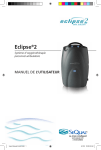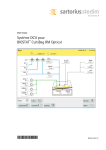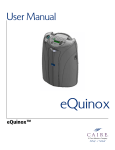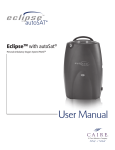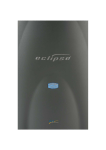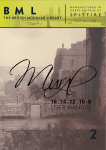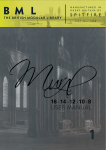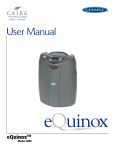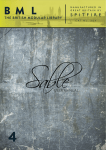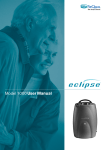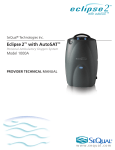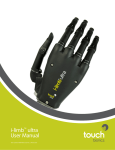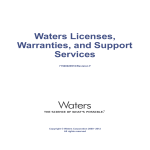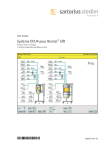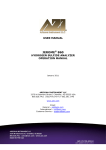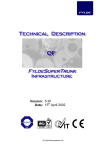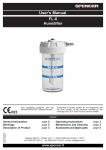Download Eclipse®2 - Sleep Restfully, Inc.
Transcript
Eclipse®2 Personal Ambulatory Oxygen System USERS MANUAL www.sequal.com 800.826.4610 CONTENTS 4-5 IMPORTANT SAFETY INSTRUCTIONS Symbols used in Users Manual and on the 4-5 Eclipse Personal Ambulatory Oxygen System 6 INDICATIONS FOR USE 6 CONTRAINDICATIONS 7-10 SAFETY GUIDELINES 7 Oxygen Therapy Safety 8-9 Operating Safety 10 Power Cartridge Safety 11-12 INTRODUCTION TO YOUR ECLIPSE 13-15 UNDERSTANDING THE CONTROLS AND FRONT PANEL 13 Description of the Eclipse 14 Control Panel Features 14 User-Controls Front Panel Symbols 14 System Status Indicators 14-15 RECOMMENDED OPERATING ENVIRONMENTS The Proper Location OPERATING INSTRUCTIONS Before Operating Powering ON Your Eclipse Operating Your Eclipse ALERTS, ALARMS AND TROUBLESHOOTING STANDARD COMPONENTS AND OPTIONAL ACCESSORIES CLEANING, CARE AND ROUTINE MAINTENANCE 16-17 17 18-30 18 19 27-30 31-32 33-35 36-38 Personal Ambulatory Oxygen System Users Manual Important Safety Instructions Important Safety Instructions are shown Under the Following Headings: NOTE: SeQual® Technologies Inc. (SeQual) recommends that this Users Manual be given to each user receiving an Eclipse Personal Ambulatory Oxygen System. This Users Manual provides all of the necessary information needed for a user, or caregiver, to successfully operate the Eclipse. WARNING Important safety information for hazards that might cause serious injury. CAUTION Important information for preventing damage to the Eclipse. DO NOT: Information needing special attention. Important! Clarifying information, specific instructions, or user reference information. Symbols Used in the Users Manual and on the Eclipse Refer to this section for an explanation of the symbols and the Warnings that accompany them. “Read Instructions”: Please consult the Users Manual instructions provided with the product. “Attention or Caution”: Indicates important information that requires the user to take special precautions when certain conditions are present. “No Smoking or Open Flames”: The use of oxygen requires that special care be taken to reduce the risk of fire. Materials that burn in air, and even some materials that will not burn in air, are easily ignited and burn more rapidly in high concentrations of oxygen. For safety concerns, all possible sources of ignition must be kept away from the Eclipse and preferably out of the room in which it is being used. Smoking in the proximity of an operating Eclipse is dangerous, and can permanently damage the device and void the warranty. “Use No Oils or Grease”: Indicates important information about the possibility of spontaneous and violent ignition that may occur if oils, grease or other petroleum based substances come into contact with oxygen under pressure. IPXO Drip Proof Equipment-IPX0: The Eclipse enclosure does not provide protection against the harmful effects of the ingress of liquids. (IPX0, per IEC 60529) IPX1 Drip Proof Equipment-IPX1: The Eclipse AC and DC Power Supplies provide protection against the harmful effects of the ingress of liquids. (IPX1, per IEC 60529) IEC Icon for DC Power (Input) “Type B Equipment”: Indicates equipment providing a particular degree of protection against electric shock, particularly regarding: A • Allowable leakage current; • Reliability of the protective earth connection (grounding). “Amperes” “Alternating Current” “Audible Alarm”: An audible indicator is provided to announce a reduction in oxygen concentration or when the power has been interrupted or lost. “ON/OFF”: Powers the device ON and OFF, but does not directly disconnect the mains power. “Increase Flow Setting”: Increases the flow setting in 0.5 increments each time the button is pressed. “Decrease Flow Setting”: Decreases the flow setting in 0.5 increments each time the button is pressed. “Flow Mode”: Activates either Continuous Flow Mode or Pulse Flow Mode Operation. “External Power is Present Indicator”: Indicates the presence of external power to operate the Eclipse. “Power Cartridge Status Gauge”: Shows the amount of charge remaining in the Power Cartridge. “Power Cartridge Symbol”: The symbol on the Power Cartridge (Battery). 02 “Oxygen Output”: The port from which the oxygen flows and where the tubing or interface (standard nasal cannula, OxyCannula™ or OxyMask™) is attached. THE U.S. FEDERAL AVIATION ADMINISTRATION (FAA) HAS APPROVED THIS DEVICE FOR USE ONBOARD COMMERCIAL AIRCRAFT. Personal Ambulatory Oxygen System Users Manual Indications for Use THE ECLIPSE IS INDICATED FOR THE ADMINISTRATION OF SUPPLEMENTAL OXYGEN. THE DEVICE IS NOT INTENDED FOR LIFE SUPPORT NOR DOES IT PROVIDE ANY PATIENT MONITORING CAPABILITIES. YOUR PHYSICIAN HAS PRESCRIBED A SPECIFIC OXYGEN FLOW SETTING TO MEET YOUR INDIVIDUAL NEEDS. RECOMMENDED OXYGEN FLOW SETTINGS SHOULD BE ADJUSTED ONLY UNDER THE ADVICE OF A PHYSICIAN WARNING FEDERAL U.S. LAW RESTRICTS THIS DEVICE TO SALE BY OR ON THE ORDER OF A PHYSICIAN. Contraindications WARNING WARNING WARNING WARNING THE ECLIPSE IS NOT INTENDED FOR LIFE SUPPORTING OR LIFE SUSTAINING APPLICATIONS, NOR DOES IT PROVIDE ANY PATIENT MONITORING CAPABILITIES. IN CERTAIN CIRCUMSTANCES, THE USE OF NONPRESCRIBED OXYGEN CAN BE HAZARDOUS. THIS DEVICE SHOULD ONLY BE USED WHEN PRESCRIBED BY A PHYSICIAN. NOT FOR USE IN THE PRESENCE OF FLAMMABLE ANESTHETICS. AS WITH ANY ELECTRICALLY POWERED DEVICE, THE USER MAY EXPERIENCE PERIODS OF NON-OPERATION AS A RESULT OF ELECTRICAL POWER INTERRUPTION, OR THE NEED TO HAVE THE ECLIPSE SERVICED BY A QUALIFIED TECHNICIAN. THE ECLPISE IS NOT APPROPRIATE FOR ANY PATIENT WHO WOULD EXPERIENCE ADVERSE HEALTH CONSEQUENCES AS THE RESULT OF SUCH TEMPORARY INTERRUPTION. WARNING Use of an oxygen mask, other than the Southmedic™ OxyMask, at low flows (1-3 LPM) is contraindicated due to the possibility of rebreathing exhaled carbon dioxide. Safety Guidelines This section of the manual provides Warnings and Cautions that apply to hazards or unsafe practices that could result in serious injury or property damage. Keep the Eclipse and the power cord away from hot surfaces or open flames. DO NOT use the Eclipse if it has a damaged power cord or plug. Your Eclipse should be located in a well-ventilated area to allow for adequate air intake. Avoid the intake of airborne pollutants, smoke and fumes. ONLY use this device with accessories specified by, or recommended by, SeQual Technologies Inc. If the Eclipse has been dropped, damaged or exposed to water please contact your home care provider for inspection or possible repair of the device. DO NOT drop or insert any objects into any opening on the device. DO NOT block the air inlet or the exhaust vent of the Eclipse when it is on a soft surface, such as a carpet, bed, couch, chair or automobile seat. DO NOT cover the device with a blanket, towel or quilt, etc. When using the Eclipse in any vehicle, be sure it is properly secured, belted or otherwise restrained. DO NOT overfill the optional humidifier. Fill the optional humidifier with water only to the level shown by the manufacturer of the humidifier. Personal Ambulatory Oxygen System Users Manual Safety Guidelines (continued) WARNING WARNING WARNING WARNING WARNING DO NOT remove the cover. There are no user-serviceable parts inside the device. Only qualified service personnel should remove the cover of the device. DO NOT operate the device, components or accessories on wet surfaces or in standing water and DO NOT submerse or expose to water. The Eclipse cover does not provide protection against the harmful effects of the ingress of liquids. Electrical shock or damage to the device may occur. Protect electrical power cords from sharp edges. Electrical shock and serious physical injury may occur. Only use the SeQual supplied AC Power Supply and DC Power Supply with your Eclipse. Use of any other AC or DC Power Supply may be hazardous, cause serious damage to your Eclipse and will void the warranty. Availability of an alternate, or back-up, source of supplemental oxygen is recommended in case of a power outage or a mechanical failure of the device. WARNING WARNING The Power Cartridge may explode and cause potential injury if exposed to a fire, or disposed of in a fire. DO NOT short-circuit the Power Cartridge’s metal contacts with metallic objects, such as keys or coins. This may cause sparks or excessive heat to be generated. CAUTION Always disconnect AC Power Supply from the wall before disconnecting the AC Power Supply Plug from the Eclipse. CAUTION Locate oxygen supply tubing and all power cords in a manner to prevent tripping hazards. CAUTION CAUTION DO NOT place the Eclipse in a small, enclosed space, such as a bathroom or closet, with the oxygen cannula or tubing leading out of the enclosed space. DO NOT expose the device to temperatures outside of the specified range of operating or storage temperatures as this may damage the device. Personal Ambulatory Oxygen System Users Manual Power Cartridge Safety WARNING 10 DO NOT disassemble, puncture, or crush the Power Cartridge. Power Cartridge electrolytes may be toxic if swallowed and can be harmful to skin and eyes. Keep the Power Cartridge away from children. WARNING Use of a damaged Power Cartridge may cause personal injury. WARNING Exposing the Power Cartridge to water or other liquids may cause personal injury. CAUTION DO NOT expose the Power Cartridge to temperatures above 140° F (60°C), such as in a vehicle parked in the sun on a hot day. CAUTION Charging the Power Cartridge below 50 F° (10° C) or above 104° F (40° C) may degrade the performance of the Power Cartridge. CAUTION DO NOT drop the Power Cartridge or expose it to mechanical shock. CAUTION Only use the Power Cartridge for its intended purpose. INTRODUCTION TO YOUR 11 Personal Ambulatory Oxygen System Users Manual This Users Manual will inform you about the use and care of the ECLIPSE, its standard components and the optional accessories. Please read thoroughly all of the information in this manual before operating your Eclipse. Contact your home care provider for proper training on the use and care of this device. YOUR PHYSICIAN HAS PRESCRIBED SUPPLEMENTAL OXYGEN AS PART OF A TREATMENT PLAN. LONG-TERM OXYGEN THERAPY (LTOT) IS NOW WIDELY ACCEPTED AS THE STANDARD TREATMENT FOR CHRONIC HYPOXIA CAUSED BY CHRONIC OBSTRUCTIVE PULMONARY DISEASE (COPD). LTOT HAS BECOME MORE VERSATILE IN RECENT YEARS DUE TO THE DEVELOPMENT OF NEW OXYGEN CONCENTRATORS. THE ECLIPSE IS AN OXYGEN CONCENTRATOR THAT MAKES IT EASIER FOR YOUR PHYSICIAN TO SELECT A MODALITY OF LTOT THAT MEETS YOUR INDIVIDUAL LIFESTYLE NEEDS. THE ECLIPSE MAY BE USED IN THE HOME, AN INSTITUTION, A MOTOR VEHICLE OR IN A COMMERCIAL AIRPLANE. THE USE OF THE ECLIPSE IN HOSPITALS SHOULD INCLUDE THE USE OF THE OPTIONAL SEQUAL HOSPITAL GRADE POWER CORD. YOUR PHYSICIAN HAS PRESCRIBED SPECIFIC OXYGEN FLOW SETTINGS TO MEET YOUR INDIVIDUAL CLINCIAL NEEDS. THESE FLOW SETTINGS ARE DETERMINED BY THE AMOUNT OF OXYGEN YOU NEED AT REST, DURING EXERCISE AND WHEN TRAVELING. RECOMMENDED OXYGEN FLOW SETTINGS SHOULD BE ADJUSTED ONLY UNDER THE ADVICE OF YOUR PHYSICIAN. 12 Understanding the Controls and Front Panel DESCRIPTION OF THE ECLIPSE 2 Become familiar with the key features of the Eclipse and the user control panel. Control Panel Service Port Handle (Not for Patient Use) External Power Receptacle Air Inlet Filter Oxygen Outlet Port Cart Insert Screw Power Cartridge Power Cord Retainer Simplified User Instructions (Under Base) Exhaust Vent Power Cartridge Latch FRONT Main/Rating Label (Under Base) BACK Input/Output Connections Oxygen Outlet Port Oxygen supply tubing or a cannula is attached to this port. Air Inlet Filter Ambient air is drawn into the device through the air inlet located at the top and rear of the device. This air inlet filter prevents dust and debris from entering the Eclipse and should be cleaned regularly. Service Port This connection allows qualified service personnel to diagnose and monitor the Eclipse performance. It is not intended for the user. External Power Receptacle The Eclipse AC or DC Power Supply power cords may be connected to this receptacle. Exhaust Vent Exhaust air from the Eclipse leaves the device from this vent. Power Cord Retainer Retainer to secure the Power Cord. 13 Personal Ambulatory Oxygen System Users Manual Understanding the Controls and Front Panel (continued) User Controls And System Status Indicators The Eclipse user control panel displays important operating information. This section will help you understand this operating information. Green, Yellow, and Red Indicators on the front panel indicate the operating condition of the device. For additional information on these indicators see the Alerts, Alarms and Troubleshooting Table in this manual. ON/OFF Button (Green) Indicator: This button powers the device ON or powers it OFF. The Green Indicator is illuminated when the device is powered ON. Increase or Decrease Flow Setting Button: Use these buttons to set the flow to your prescribed level. Flow Mode Button and Indicator: The Eclipse contains a button to toggle between Continuous Flow and Pulse Flow mode. The Pulse Flow mode allows a significant increase in the duration-of-use time the device can operate from the Power Cartridge. When the Pulse Flow Mode is activated, the green Flow Mode Indicator illuminates and a pulse of oxygen is delivered with each inspiratory effort. When the pulse of oxygen is delivered, the flow mode indicator turns off. Changes in flow mode should only be made on the recommendation of your physician. 14 ALERT (Yellow) Indicator - Low and Medium Priority Alerts: When illuminated, this indicates a low priority awareness condition or Caution. Continue to use your system and refer to the Alerts, Alarms, and Troubleshooting Table for the proper response. A flashing yellow indicates a medium priority alert. A prompt response is necessary. ALARM (Red) Indicator – High Priority Alarms: Indicates a high priority alarm condition. An immediate response is necessary. Refer to the Alerts, Alarms, and Troubleshooting Table and contact your home care provider. Buzzer: An audible alarm (or buzzer) is used to alert you to the operating condition of the device, either a warning or failure, and to confirm a valid key press by the user. Flow Setting Indicator: This is the main focus on your control panel. Your home care provider will correctly set your prescribed flow for either the Continuous Flow Mode (LPM) and/or your Pulse Flow Mode settings. DO NOT change these settings unless it is with the recommendation and under the order of your physician. Each time you power the device ON, the previous flow mode and flow setting has been saved and will be used at start-up. Power Cartridge Status Gauge: This indicator displays the charge remaining in the Power Cartridge. When the Power Cartridge is fully charged all 4 gray bars are illuminated. Each gray bar represents approximately 25% of the total Power Cartridge charge. When the Power Cartridge is being charged, the charge indicator bars will blink in a waterfall-type fashion. If the Power Cartridge is not installed, or if it is improperly installed, the Power Cartridge Status Gauge will not be illuminated. External Power is Present Indicator: When the Eclipse is properly plugged in and is using the AC or DC Power Supply, this indicator will appear on the User Control Panel. 15 Personal Ambulatory Oxygen System Users Manual Recommended Operating Environments The following chart provides important information concerning the recommended operating environments, or operating conditions, for proper use of the device. Operating Temperature 50º F to 104º F (10º C to 40º C) Operating Humidity 10% - 95% at an 82.4° F (28° C) dew point Transport/Storage Temperature -4º F to 140º F (-20º C to 60º C) Humidity: Up to 95% Non-Condensing Electrical Use no extension cords. Use no electrical outlets controlled by a switch. Altitude 0 – 13,123 feet (0 - 4,000 meters) Placement DO NOT block the air inlet or the exhaust vent. Place device a minimum of 3 inches (7.5 cm) away from walls, draperies, furniture, etc.) Environment Must be smoke, pollutant, and fume free. Operating Time 24-hours per day when connected to an external AC or DC power source. NOTE: When moving the Eclipse from an extreme temperature environment, please allow time for your device to acclimate to the recommended operating temperature environment. WARNING 16 Operating your Eclipse outside of the recommended operating temperature environment may negatively impact device performance, may cause damage to the device and will void the warranty if this occurs. The Proper Placement Select a location for the device that avoids the intake of smoke, fumes and pollutants. Correct placement of the device should allow intake of air through the air inlet filter at the back and rear of the cabinet and allow exhaust air to freely leave the exhaust vent at the bottom of the device. Locate the device such that the alarms can be heard. Position the oxygen supply tubing in such a way that it does not kink or occlude. DO NOT locate the device near flammable materials or cleaning agents or in the direct path of any heat source, such as a stove, range, heat register or car heater. Keep the Eclipse at least five (5) feet (1.5 m) away from hot, sparking objects or open flames. CAUTION Locate the device in a well-ventilated area that provides adequate air movement. Periodically check if air is being prevented from entering or exiting the device by obstructions such as furniture, draperies, bedding, clothing or pets. 17 Personal Ambulatory Oxygen System Users Manual Operating Instructions BEFORE OPERATING This users manual serves as your reference to help you operate and maintain the device. If you have any questions or concerns please call your home care provider, qualified representative, or SeQual Technologies Inc. Important! DO NOT attempt to operate the Eclipse without first reading the Safety Guidelines section of this manual. Please follow all of the operating instructions. Please observe all Warnings on the device and in the users manual. In order to reduce the risk of fire, personal injury and serious damage to the Eclipse, please observe all of the safety precautions. WARNING CAUTION 18 Protect the Eclipse and the AC and DC Power Supplies from all fluid spills or fluid drips to avoid possible shock hazards. Always check that the Air Inlet and the Exhaust Vent of the device are not blocked and that the Air Inlet Filter is clean before using your device. POWERING ON YOUR ECLIPSE The Eclipse is a lightweight portable and stationary source of supplemental oxygen. The device is capable of being operated directly from three different power sources: (1) AC Power Supply, (2) DC Power Supply and (3) Rechargeable Power Cartridge (Battery). (1) AC Power Supply (2) DC Power Supply (3) Rechargeable Power Cartridge (Battery) The Eclipse charges the optional Power Cartridge when external power (AC or DC) is present and when the Power Cartridge temperature is below a safe charging temperature. When external power is disconnected, the device will automatically switch over to the Power Cartridge, if installed and charged. When external power is restored, by plugging into an AC or DC outlet, the device will accept power from the external power source and replenish the Power Cartridge while operating the device if adequate AC or DC power is available. Proper connection of the AC or DC Power Supply requires aligning the power plug with the recessed external power receptacle of the device. The recessed external power receptacle is located on the right side of the device when facing the user control panel. Push the power plug into the recessed receptacle. 19 Personal Ambulatory Oxygen System Users Manual Operating Instructions (continued) WARNING WARNING (1) DO NOT touch the Power Compartment metal connectors inside the cabinet with the Power Cartridge removed when the device is connected to an external AC or DC power source. This may result in an electrical shock! AC POWER SUPPLY: The Eclipse includes a universal AC Power Supply for use at home, or wherever standard AC power is available. To connect to an AC power source, be sure the AC Power Supply device cord is securely inserted into the recessed power receptacle on the side of the device and that the AC power cord from the AC Power Supply is plugged into a grounded AC outlet. When the device is plugged in properly, a green indicator on the AC Power Supply will light and the External Power is Present Indicator, will appear on the user control panel. CAUTION CAUTION CAUTION 20 DO NOT use any power cord if it is damaged or frayed. Improper use of the Power Cord may result in a fire or electrical shock hazard. The AC power cords used with the Eclipse must meet the electrical requirements of the country where the device is used. Use only with a grounded, 3-pin receptacle. DO NOT remove the grounding pin from the power cord. Use only with SeQual supplied power cords. DO NOT connect the Eclipse to an extension cord or to an electrical outlet controlled by a switch. CAUTION (2) Always unplug the AC Power Cord from the wall before disconnecting the plug from the Eclipse. DC POWER SUPPLY: A DC Power Supply allows the system to operate from DC outlets, such as those found in motor vehicles. You will need to determine the fuse rating in your motor vehicle. It will be either a 15 AMP or a 20 AMP fuse rating. This is accomplished by consulting your motor vehicle’s Operator’s Manual or, by examining the fuse box in the vehicle. Once you have confirmed the motor vehicle’s fuse rating, set the switch on the DC Power Supply to the appropriate fuse rating setting. Note: Use the 10 AMP position on the DC Power Supply for a 15 AMP vehicle fuse rating and use the 15 AMP position for a 20 AMP or greater vehicle fuse rating. Start your vehicle. Insert the DC cord into the recessed power receptacle on the side of the device. Next, insert the DC Power Supply plug into the DC power outlet in your motor vehicle. When the device is properly connected and receiving power from the DC power source, a green indicator light on the Power Supply and on the External Power is Present Indicator, on the control panel will illuminate. WARNING WARNING WARNING Secure the Eclipse and the DC Power Supply in your vehicle and be sure there is adequate air flow to the device and that the air inlet and exhaust vents are not blocked. Blocking of the air inlet or exhaust vent may impair device performance. DO NOT leave the Eclipse or DC Power Supply plugged into the vehicle without the engine running or attempt to start the vehicle while the DC Power Supply is connected to the vehicle. Doing so will drain the vehicle’s battery. If the vehicle’s DC power source drops below 11.5 Volts (brownout condition) the Eclipse will revert to Power Cartridge operation (if the Power Cartridge (battery) is present). The External Power is Present Indicator may remain on. Note: When operating the device from a DC power supply, it is recommended that the Pulse Flow Mode be used. This will help conserve motor vehicle battery life. Consult with your physician if you do not have a prescribed pulse flow setting. 21 Personal Ambulatory Oxygen System Users Manual Operating Instructions (continued) DEVICE FLOW SETTINGS AVAILABLE FOR EACH FUSE SETTING Flow Available with 10 AMP Available with 15 AMP Setting Continuous Pulse Continuous Pulse 0.5 Yes Not Available Yes Not Available 1.0 Yes Yes Yes Yes 1.5 Yes Yes Yes Yes 2.0 Yes Yes Yes Yes 2.5 NO Yes Yes Yes 3.0 NO Yes Yes Yes 3.5 - Yes - Yes 4.0 - Yes - Yes 4.5 - Yes - Yes 5.0 - Yes - Yes 5.5 - Yes - Yes 6.0 - Yes - Yes Note: Actual performance may vary depending upon usage conditions and the motor vehicle. Note: When operating in the 10 AMP switch position, with device flow settings greater than 2.0 LPM continuous flow, the device will automatically switch to the 2.0 LPM continuous flow setting when the DC Power Supply is connected to conserve DC power and improve duration-of-use. (3) RECHARGEABLE POWER CARTRIDGE: The Eclipse can be powered by the rechargeable Power Cartridge (battery), which is supplied with the device. Installing the Power Cartridge: Align the Power Cartridge so that it will slide into the empty Power Compartment. Push the Power Cartridge into the empty Power Compartment until it locks into position and flush with the back of the device. When the Power Cartridge is properly installed and the Eclipse is ON, the Power Cartridge Status Gauge will appear on the Control Panel. (If you DO NOT have a Power Cartridge installed, the Power Cartridge Status Gauge will not illuminate). 22 To remove the Power Cartridge, push up on the release lever on the Power Cartridge. The Power Cartridge will slide out as you grasp it for removal. Power Cartridge Duration-of-Use: The duration-of-use of the Power Cartridge is displayed at the top of the user control panel. A variety of factors, such as flow setting, Pulse or Continuous Flow Mode will impact the duration-of-use. The following table provides duration-ofuse estimates for the Eclipse operating on a fully charged Power Cartridge given certain flow settings and operating conditions. TYPICAL NEW POWER CARTRIDGE DURATION-OF-USE Power Cartridge FLOW SETTING Continuous Flow Mode (LPM) Pulse Flow Mode (Setting) 0.5 4.4 hours - 1.0 3.7 hours 4.4 hours 2.0 2.4 hours 3.6 hours 3.0 1.3 hours 3.0 hours 4.0 - 2.6 hours 5.0 - 2.3 hours 6.0 - 2.1 hours Note: Times will degrade with Power Cartridge use, over time, and the increasing age of the Power Cartridge. CAUTION Store the Power Cartridge in a cool and dry location. This will help to assure the longevity of your Power Cartridge. 23 Personal Ambulatory Oxygen System Users Manual Operating Instructions (continued) CAUTION CAUTION DO NOT attempt to open the Power Cartridge, there are no serviceable parts inside the Power Cartridge. CAUTION Only replace the SeQual Power Cartridge supplied with the device with a SeQual Power Cartridge. CAUTION Return the Power Cartridge to your home care provider, or SeQual Technologies for proper disposal. CAUTION Keep the Power Cartridge away from children. CAUTION 24 U.S. Department of Transportation (DOT) and United Nations (UN) Regulations require the removal of the Power Cartridge from the device for all international airline travel when the Eclipse is checked as luggage. When shipping the Eclipse, the Power Cartridge must also be removed from the device AND PACKAGED PROPERLY. DO NOT disassemble, incinerate, or heat the Power Cartridge above 140° F (60° C). The Power Cartridge, used in this device, may present a risk of fire or chemical burn if mistreated. TYPICAL POWER CARTRIDGE RECHARGE TIME The typical time to recharge your Power Cartridge, in order to achieve 80% capacity, from a fully discharged Power Cartridge is between 1.4 hours and 5.0 hours, depending upon the device flow setting. If the Power Cartridge becomes too warm during discharging, recharging will not begin until the Power Cartridge sufficiently cools. Removing the Power Cartridge and allowing it to cool may expedite this cooling process. The Power Cartridge may not recharge, or the charge time may increase significantly, when operating from the DC Power Supply set in the 10 AMP position. INITIAL POWER CARTRIDGE charging The new Power Cartridge supplied with your Eclipse is not fully charged when it is shipped from the factory. Before using your Eclipse for the first time, you must first fully charge the Power Cartridge. Power your Eclipse ON, with the AC Power Supply plugged in, and the Power Cartridge correctly installed in the Power Compartment of the device. With the device powered ON, allow the Power Cartridge to completely charge. The Power Cartridge is fully charged when the Power Cartridge Status Gauge Indicator, at the top of the device, is completely illuminated or the device has been charging for a minimum of 5 hours. NOTE: The Eclipse can be used when either discharging or recharging of the Power Cartridge is taking place. 25 Personal Ambulatory Oxygen System Users Manual Operating Instructions (continued) WARNING CAUTION CAUTION CAUTION DO NOT tamper with, disassemble, crush or heat the Power Cartridge above 140° F (60° C). Tampering with the Power Cartridge may present a risk of fire or explosion and will void the warranty. Store the Power Cartridge in a cool and dry place when not in use. DO NOT leave your Eclipse, or your Power Cartridge, in the seating area of your motor vehicle or in the trunk of your motor vehicle during a hot day. NOTE: The storage temperature range for the device is -4°F (-20°C) to +140°F (+60°C) and 95% non-condensing humidity. The Eclipse will only operate with a SeQual Power Cartridge. Use of any another Power Cartridge or battery, may damage the device, may present a risk of fire or explosion and will void the device warranty. In the event of an AC power interruption, the Eclipse will automatically switch to the Power Cartridge operation. When AC power is restored, the Power Cartridge will automatically start recharging. If the Power Cartridge is not present, or fully discharged, during an AC power interruption, the Eclipse will shut down. The Power Cartridge is fully discharged when the Power Cartridge Status Gauge, at the top of the device, is no longer illuminated. The device will sound a low Power Cartridge alert until the device completely shuts down. This audible alert could continue for up to approximately 20 minutes until the device shuts down. NOTE: Press and hold the Eclipse ON/OFF button for a minimum of 5 seconds, this will silence the Loss of Power alarm. Connecting the Eclipse to an external AC power supply will also eliminate this alarm. 26 OPERATING YOUR ECLIPSE FOR THE FIRST TIME Step 1: Locating your Eclipse. Place the Eclipse in a well-ventilated area. Be sure the air inlet and exhaust vent are not obstructed. Position the Eclipse so that all audible and visual indicators or alarms can be easily seen and heard. Be sure the air inlet filter is in place before operating your Eclipse. If the air inlet filter is missing, contact your home care provider. If the air inlet filter is dirty, wash with warm soapy water, rinse with clear water and allow it to dry before placing the air inlet filter back in the device. If necessary, replace it with a new clean air inlet filter. Plug the device into a grounded AC Power outlet, a DC Power source, or be sure there is a fully charged Power Cartridge installed. Step 2: Power ON the Device and Allow it to Warm Up Press and hold the “ON/OFF” Button for one (1) second to power ON your Eclipse. A brief audible and visual power on self-test (POST) will occur. Verify that all the indicators are illuminated and that a buzzer sounds for three (3) seconds indicating the device is operating properly. NOTE: If during POST, there are three beeps, this indicates a low battery condition for the 9-volt battery inside the cabinet of the Eclipse. Please contact your home care provider and request that the 9-volt battery be replaced. DO NOT open the cabinet. Warm-up Period • Oxygen Monitoring – The Eclipse has an oxygen concentration status indicator (OCSI) built-in to the device. The OCSI continually monitors the oxygen output of the device. The OCSI incorporates a green light (normal), yellow light (alert) and red light (alarm) and a buzzer. The red, yellow, and the green (normal) indicators will all illuminate during the power on self-test (POST) at start-up and then the red and yellow indicators will sequentially go out when the oxygen purity of the device is within performance specifications. • After initially powering ON the device, please allow up to five (5) minutes for the device to reach its performance specifications. The user control panel will indicate the device is warming up by having the green, yellow and red lights illuminated. When the green (normal) indicator light only is illuminated, the device has reached its performance specifications. 27 Personal Ambulatory Oxygen System Users Manual Operating Instructions (continued) Step 3: CONNECT THE OXYGEN SUPPLY TUBING TO THE OXYGEN OUTLET AND CONNECT THE OXYGEN CANNULA PER THE INSTRUCTIONS PROVIDED WITH THE CANNULA, OR PER THE INSTRUCTIONS FROM YOUR HOME CARE PROVIDER. Replace the cannula and oxygen supply tubing regularly, as recommended by your home care provider. Consult your home care provider for cannula and supply tubing cleaning and replacement information. Step 4: SELECT THE FLOW DELIVERY MODE Press the Flow Mode button to select the desired flow mode. Pressing this button repeatedly will toggle you back and forth between the flow modes. The proper flow mode and proper flow setting should be prescribed for you by your physician. Continuous Flow Mode Operation • When operating in the Continuous Flow Mode, a continuous supply of oxygen measured in liters per minute (LPM) will flow through your tubing and nasal cannula. WARNING DO NOT use supply tubing or cannula extensions that are more than 50’ (15.2m) in length in the Continuous Flow Mode. PULSE FLOW MODE OPERATION: • Pulse Flow Mode should only be used under the direction of a qualified clinician or physician. Proper pulse flow mode settings should accommodate your individual oxygen needs at rest, during exercise and when traveling. • When operating in Pulse Flow Mode a yellow visual alert will occur after 45 seconds have elapsed and there is no inspiratory effort detected by the device. If an additional 15 seconds elapses (60-seconds total time) with no inspiratory effort detection, the device will switch to the Continuous Flow Mode. The device will use the last Continuous Flow setting when this occurs. The yellow visual alert will cease at this time. 28 Pulse Flow Mode and AutoSatTM Technology Features Your Eclipse has a feature, called AutoSat™ Technology that provides a consistent bolus of oxygen for higher breath rates during exercise, while you are ambulating or operating the Eclipse from the DC Power Supply. Pulse Setting Bolus Size Max Breath Per Minute (bpm) 1 16 40 2 32 40 3 48 40 4 64 39 5 80 31 6 96 26 Note: Bolus volume decreases as breath rate exceeds published range. WARNING WARNING WARNING 10 AMP SETTING DC Power Supply OPERATION Bolus Volume (+/- 15%) Bolus Volume (+/- 15%) AC Power Supply OPERATION Power CARTRIDGE OPERATION 15 AMP SETTING DC POWER SUPPLY OPERATION Pulse Setting Bolus Size Max Breath Per Minute (bpm) 1 16 40 2 32 40 3 48 40 4 64 31 5 80 25 6 96 20 Note: Bolus volume decreases as breath rate exceeds published range. Pulse Flow Mode settings must be determined for each patient individually for their needs at rest, during exercise and when traveling. Settings used in the Continuous Flow Mode may not apply, or be appropriate, in the Pulse Flow Mode and vice versa. DO NOT exceed 7 feet (2.1m) in length of supply tubing or cannula tubing when operating in the Pulse Flow Mode in order to ensure adequate inspiratory effort detection. As with all oxygen-conserving type devices, the Eclipse may not be able to detect all inspiratory efforts in the Pulse Flow Mode. 29 Personal Ambulatory Oxygen System Users Manual Step 5: ADJUST THE FLOW SETTING TO THE PRESCRIBED LEVEL Using the Flow Setting Buttons, adjust the flow setting to the prescribed setting supplied by your physician. WARNING DO NOT change from prescribed flow setting without consulting with a qualified clinician or physician. Step 6: BEGIN USING YOUR ECLIPSE Breathe normally through the nasal cannula. NOTE: You will achieve longer duration-of-use when operating your device from the Power Cartridge if you operate your Eclipse in the Pulse Flow Mode. Step 7: MOBILE CART OPERATION The Mobile Cart is designed for use on pedestrian-type surfaces. Align the locator holes on the bottom of the device to the tabs on the Mobile Cart. Align the large threaded screw to the insert at the back of the Eclipse. Then hand-tighten the knob on the mobile cart until the Mobile Cart is tightly secured to the device. Depress the push-button on the Mobile Cart handle to adjust the height of the handle. Step 8: POWER OFF THE DEVICE Press and hold the “ON/OFF” Button for two (2) seconds to power OFF your Eclipse. Store the Eclipse in a cool and dry location. 30 Alerts, Alarms, and Troubleshooting Table This table shows the possible audible and visual alerts and alarms, their conditions and suggests appropriate troubleshooting responses. If you are unsure about any alerts or alarm conditions, or responses please contact your home care provider or go to www.sequal.com. Green Indicator Yellow Indicator Red Indicator Audible Alarm “Warming Up. Please Wait.” On On On Off Wait. The system typically takes 3 - 5 minutes to reach specified performance. “3.0” (or flow setting) On Off Off None Nothing. The system is operating properly at the specified flow rate. “Low or Warm Power Cartridge” On Blinking Off Beeps Plug into external power or replace with a charged Power Cartridge. “9-Volt Battery” On On On 3 Beeps The internal 9-volt battery needs replaced. Contact dealer/provider for replacement. “O2 Concentration < 85%” Off Blinking Off Off Continue Use. Check or clean air intake filter. If condition persists, contact dealer/provider. “O2 Concentration < 70%” Off Off Blinking Beeps Continue Use. Check or clean air intake filter. If condition persists, contact dealer/provider. “Flow Rate Error /Blocked Flow” Off Blinking Off Beeps Check tubing and/or humidifier for obstruction. Check/clean air intake filter. If condition persists past 10 minutes, contact dealer/provider. “Cannot Charge Power Cartridge” Off On Off Off Seek external power source. Remove Power Cartridge and allow to cool to room temperature. If Power Cartridge malfunction persists, contact home care provider. “No Inspiratory Effort Detected” (in Pulse Flow Mode only) On On Off On Make sure tubing does not exceed 7 ft (2.1m) when using Pulse Flow Mode. Audible alarm will beep after 45 seconds if no inspiratory effort is detected. If no inspiratory effort is detected 15 seconds after that, the Eclipse will automatically switch to Continuous Flow Mode of operation. “Power Cartridge Shutdown or hot Power Cartridge” (with no external power present) Off Off Blinking On Seek external power source. Remove Power Cartridge and allow to cool to room temperature. If Power Cartridge malfunction persists, contact home care provider. “Loss of External Power” (without charged Power Cartridge installed) *Note: Stars will be flashing in the LCD ********.” Off Off Blinking On Seek an alternative oxygen supply until external power is restored or install a charged Power Cartridge. “System Malfunction” Off Off On On 10 seconds then silent Contact home care provider. Use back up oxygen supply. SHUTDOWN CONDITIONS DEVICE NEEDS ATTENTION TYPICAL CONDITIONS Condition What to do 31 Personal Ambulatory Oxygen System Users Manual WARNING AVAILABILITY OF A BACK-UP SOURCE OF OXYGEN IS RECOMMENDED IN CASE OF POWER OUTAGE OR A DEVICE FAILURE. CONSULT YOUR provider FOR BACK-UP oxygen SYSTEM. DO NOT Ignore Alarms. SYMPTOM Eclipse does not power on when ON/OFF button is pressed No Oxygen Low Oxygen Concentration Low Oxygen Flow No Oxygen delivered in Pulse Flow Mode Power Cartridge Status Gauge never indicates fully charged 32 PROBABLE CAUSE REMEDY No Power Cartridge installed Install Power Cartridge or plug into external power Power Cartridge is discharged or no external power is present Plug into external power Other Contact your dealer/provider Filter Blocked Clean Air Inlet Filter Humidifier Check humidifier attachment and tubing Eclipse not ON Power Eclipse ON Tubing or cannula is not properly connected or kinked Check tubing, cannula and connections Other Contact your dealer/provider Restriction in tubing or humidifier Repair or replace tubing or humidifier. Place your Eclipse so there is adequate air flow. Filter restricted Clean or replace air inlet filter. Place your Eclipse so there is adequate air flow. Other Contact your dealer/provider Restriction in humidifier or tubing Repair or replace humidifier or tubing Filter Blocked Clean or replace air inlet filter Other Contact your dealer/provider Tubing/cannula longer than 7 feet (2.1m) Attach 7 foot (2.1m) tubing/cannula Humidifier attached Remove humidifier No inspiration detected Contact your dealer/provider Power Cartridge is aging Contact your dealer/provider to replace Power Cartridge Eclipse Standard Components (Supplied with each Eclipse) WARNING Use of certain accessories not specified for use with this Eclipse may impair the performance. ONLY use SeQual recommended accessories. ECLIPSE Model 1000A Mobile Cart AC Power Supply Power Cartridge DC Power Supply Mobile Cart – Your Eclipse can be easily transported while attached to the Mobile Cart. The Mobile Cart has wheels and a telescoping handle for easy traveling. NOTE: The Mobile Cart can be stored beneath the seat in front of you onboard commercial aircraft when it is attached to the Eclipse. 33 Personal Ambulatory Oxygen System Users Manual Eclipse Optional Accessories Check with your home care provider,or visit us at www.sequal.com for more information about optional accessories. There are many different types of oxygen tubing, cannulae, and humidifiers. The following items are recommended by SeQual Technologies for use with your Eclipse. • Salter Labs® Humidifier, Part Number 7600, or equivalent: If your physician has prescribed an optional humidifier, follow the manufacturer’s instructions for use. Attach the humidifier to the oxygen outlet port of the Eclipse. Use of optional humidifiers not recommended for the Eclipse may impair performance of the device and may void the warranty. DO NOT use a humidifier in the Pulse Flow Mode. The Eclipse will not detect inspiratory effort. The device will alarm and default to the Continuous Flow Mode for continuing operation. • SeQual Technologies Humidifier Adapter – Part Number 3509: If your physician has prescribed an optional humidifier, you may need to use the SeQual Humidifier Adapter. Follow the instructions for use. Attach the Humidifier Adapter to the oxygen outlet port of the Eclipse and then to the humidifier. Attach the cannula, or oxygen tubing to the humidifier outlet. Salter Labs Oxygen Supply Tubing, Part Number Series 2000, or equivalent: The internal diameter should be no less than 3/16” (0.48 cm). Connect the oxygen tubing to the outlet port of the humidifier, or directly to the oxygen outlet port of the Eclipse if you do not use a humidifier. Connect the other end of the tube to the nasal cannula, if oxygen supply tubing is not already attached to the cannula. Tubing not specified for use with this Eclipse may impair the performance of the device. WARNING WARNING CAUTION 34 The tube fitting may be tight - DO NOT use oils or grease to lubricate tubing or oxygn outlet port. If tubing becomes disconnected during operation, the Eclipse does not alarm. Check flow at the cannula to verify oxygen delivery. To ensure there is adequate flow to deliver oxygen, the length of the tubing must not exceed 50 feet (15.2m) when using Continuous Flow Mode, and must not exceed 7 feet (2.1m) when operating in Pulse Flow Mode for adequate inspiratory effort detection. Salter Labs Oxygen Cannula, Part Number 1600 Series, or equivalent: Your physician will have prescribed a cannula to deliver oxygen. In most cases they are already attached to the oxygen tubing. If not, follow the instructions included with the cannula to attach it to the oxygen tubing. Use of an oxygen cannula not specified for use with this Eclipse may impair the performance of the device. Southmedic OxyCannula®, Part Number OA-PLUS-SEQ-8: Your physician will have prescribed a cannula to deliver oxygen. In most cases they are already attached to the oxygen tubing. If not, follow the instructions included with the cannula to attach it to the oxygen tubing. Use of a cannula not specified for use with the Eclipse may impair the performance of the device. Southmedic OxyMask®, Part Number OM-1100-8: For use with continuous flow mode settings from 0.5 to 3 LPM only. Use of an oxygen mask not specified for use with the Eclipse may impair the performance of the device. SeQual Power Compartment, Part Number 7084: The Power Compartment is available for use when the Power Cartridge is not installed and the Power Cartridge (battery) operation is not required. When using the Power Compartment, your Eclipse will ONLY operate from external AC and DC Power sources. SeQual Desktop Charger, Part Number 7112: Recharges the Power Cartridge in less than three hours. WARNING WARNING WARNING CAUTION Use of an oxygen mask, other than the Southmedic OxyMask, at low flows (1-3 LPM) is contraindicated due to the possibility of rebreathing exhaled carbon dioxide. DO NOT expose the AC and DC Power Supplies to water. Electrical shock or serious injury may result. DO NOT drip or spill liquids on the device. DO NOT expose the Eclipse to water during ambulatory use. The Eclipse outer shell does not protect against the harmful effects of the ingress of liquids. Electrical shock hazard or damage to the device may result. When operating the Eclipse on the mobile cart, DO NOT bang, drop or bump the device while in transport. 35 Personal Ambulatory Oxygen System Users Manual Cleaning, Care and Routine Maintenance Routine Maintenance Servicing of the internal components inside the cabinet of this device must be conducted by a SeQual trained and qualified service technician as needed. Your home care provider or qualified technician will perform inspections and maintenance of the compressor, alarms, internal 9-volt battery, Power Cartridge and other internal parts only as needed. WARNING DO NOT disassemble the Eclipse or attempt to perform any maintenance tasks other than those described in the User Care and Cleaning of the Device section below. Disassembling the Eclipse may create an electrical shock hazard and will void your warranty. Contact your home care provider, or a qualified technician for any inspection, maintenance, or repair required. User Care and Cleaning of the Device Cannula Replacement: Replace your supply tubing and cannula on a regular basis as recommended by your home care provider. Your physician or home care provider will provide you with cleaning, disinfection and replacement information. Air Inlet Filter: Ambient air is drawn into the device through the air inlet located on the top and rear of the device. Cleaning the air inlet filter is the most important maintenance activity you will perform as a user, to keep your Eclipse performing properly. Check this air inlet filter daily and clean it at least once a week using the following procedure: 1.Remove the air inlet filter; 2.Wash the filter in warm tap water using a mild soap detergent solution; 3.Rinse the filter thoroughly with clear tap water and squeeze out the excess water; 4.Allow the filter to air dry; 5.Reinsert the filter in the cabinet; 6.Cleaning tip - keep a clean second filter as a replacement for use when one filter is drying. 36 CAUTION CAUTION CAUTION The air inlet filter should be free of liquid water and dry to the touch before reinstallation. Excess moisture in the filter may impair the proper operation of the Eclipse. When the air inlet filter is removed note that the Service Port is exposed. DO NOT attach any cables to this Service Port. It is for use by a qualified service technician ONLY. DO NOT place foreign objects into or through the vent holes of the air inlet or exhaust vent. The air inlet filter should be replaced as needed. If the Eclipse is used in a dusty environment, the filter may need to be replaced more often. You should not operate the Eclipse without an air inlet filter installed for any longer than 30 minutes. AC Power Supply, DC Power Supply and Power Cord: Turn OFF the Eclipse and disconnect from AC or DC power before any cleaning or disinfection activity. DO NOT spray the cabinet. Use a damp (not soaking wet) cloth or sponge. Spray the cloth or sponge with a mild detergent solution to clean the cabinet and power supplies. To disinfect the Eclipse, use Lysol® Brand II disinfectant. Proceed as directed by the manufacturer. WARNING Unplug Power Cords, AC or DC Power Supplies before cleaning the exterior cabinet. DO NOT use denatured alcohol or apply liquid spray or aerosol cleaners to the cords or power supplies. Optional Humidifier: If used, clean your humidifier daily to reduce the possibility of contamination. Follow the cleaning recommendations provided by the home care provider, or the manufacturer of the humidifier. Replace the humidifier monthly, or as recommended by the manufacturer, or your home care provider. Mobile Cart: Before cleaning the Mobile Cart, remove it from the Eclipse. Use a damp (not soaking wet) cloth or sponge and mild detergent solution to clean the Mobile Cart. 37 Personal Ambulatory Oxygen System Users Manual Power Cartridge Cleaning, Care and Maintenance The Power Cartridge (battery) in the Eclipse requires special care to assure a longer life and the highest level of performance. The SeQual Power Cartridge is the only approved Power Cartridge recommended for use with the Eclipse. Use a damp (not soaking wet) cloth or sponge. First spray the cloth or sponge with a mild detergent then clean the Power Cartridge case and the latch. WARNING DO NOT tamper with or try to repair the Power Cartridge. There are no serviceable parts inside. Power Cartridge Disposal: Your Power Cartridge is rechargeable and can be recycled. Always return it to your home care provider for proper disposal. Or, contact us at www.sequal.com. You can also contact your local city or town offices for instructions on proper disposal of the Power Cartridge. Power Cartridge Storage: Your Power Cartridge should be stored in a cool and dry location. WARNING 38 Exposing the Power Cartridge to water or other liquids may cause personal injury or harm. Manufactured by: SeQual Technologies Inc. 11436 Sorrento Valley Road San Diego, CA 92121 USA Toll-Free: 1-800-826-4610 in the U.S., or 1-858-202-3100 Toll-Free Fax: 877-786-9943 Worldwide: www.sequal.com SeQual Technologies Europe BV. Verdunplein 10 5627 SZ Eindhoven The Netherlands Tel: + 31 40 212 8606 Fax: + 31 40 211 1240 Worldwide: www.sequal.com Home Care Provider Name, Address and Telephone Number: Prescribing Physician Name, Address and Telephone Number: Emergency Contact Name, Address and Telephone Number: SeQual® and Eclipse® and AutoSat ™ are trademarks of SeQual Technologies Inc., San Diego, CA 92121 Salter Labs® is a registered mark of Salter Labs, Arvin, CA 92303 Southmedic™, OxyCannula™ and OxyMask™ are registered trademarks of Southmedic, Inc., Barrie, Ontario, Canada, L4M5K3 Lysol® is a registered trademark of Reckitt Benckiser, UK. 39 …to outshine and surpass Manufactured by: SeQual Technologies Inc. 11436 Sorrento Valley Road San Diego, CA 92121 USA Toll-Free: 1-800-826-4610 in the U.S., or 1-858-202-3100 Toll-Free Fax: 877-786-9943 Worldwide: www.sequal.com PN: 4112 Rev: A








































